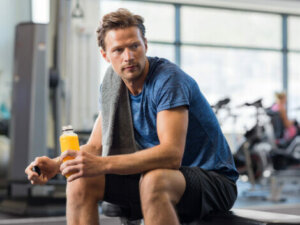Rest and Recovery for Maximum Sporting Performance

Two of the most mentioned words in sport are rest and recovery. Any well-planned exercise routine includes a significant amount of rest. In fact, a huge number of experts consider these two words to be the cornerstone of peak sporting performance.
But why are they so important? You might have your doubts, and in fact, many people dismiss the idea of rest and recovery from their routine, leading to overtraining. Others go to another extreme and rest so much that they don’t make any progress.
With this in mind, today, we’ll look at why rest and recovery are so important in sport and how you can achieve maximum sporting performance. Let’s dive in!
Rest and physical recovery
The most important features of any exercise or sports routine are technique, intensity, volume, frequency, rest, and recovery. These variables should all form part of your fitness plan if you want to achieve maximum results.
Although they’re all important, we’re going to focus today on rest and physical recovery, and there’s a close link between the two.
What is rest?
Generally speaking, rest is the period between repetitions or after a training session.
When doing physical exercise, various muscle groups suffer considerable strain, so rest needs to be completed properly. The fibers of the muscles that you’re working will suffer small tears that need to recover.
The amount of rest you’ll need depends on you as an individual and the sport that you do. But no matter how much you rest, it’s an important part of your routine.

There’s also something called active rest, which is recommended by personal trainers for those days when you can’t do your normal exercise routine. This type of rest involves doing low-intensity exercises to keep your metabolism active whilst your muscles recover.
What is recovery?
Recovery begins once you’ve finished training. In this phase, your body establishes its energy reserves and your muscles start to repair themselves. The fibers broken during training and repaired, and hormones play an important part in this process.
This process also varies according to your physical and psychological condition. Normally, elite athletes recover much quicker. However, this still takes a certain amount of time to finish.
The relationship between rest and recovery
Recovery takes place during your rest period. During recovery, the body repairs all the “damage” done during your training session.
On a physiological level, the muscle cells repair the broken fibers and the body restores the levels of intramuscular and hepatic glycogen. Also, the concentration of blood and lactic acid in the muscles also reduces. Finally, oxygen levels return to normal, although this normally happens within a minute of resting.
As you can see, there’s a close relationship between the two. Despite this, there are other things that the body needs in order to physically and psychologically recover. These include good hydration, a balanced diet, massages, and enough sleep.
Finally, it’s important to point out that this recovery period doesn’t just have an impact on the muscles that you’ve been training. Your soft tissues, joints, ligaments, and tendons also benefit from this temporary period of inactivity.

How long do I need to rest and recover
Trying to come up with a one-size-fits-all rest and recovery time would be a big mistake. The rest and recovery process should be part of a training plan devised by a professional as they’ll be able to take all the relevant factors into account.
But if you rest and recover properly, you’ll see improvements in your sporting performance. This is another reason not to base your rest periods on someone else’s training routine. Otherwise, you won’t see the results that you’re hoping for!
Always consult a professional
As we mentioned at the beginning, many athletes adopt poorly devised training plans and don’t consider how much time they actually need to rest and recover.
To avoid making the same mistake, it’s always a good idea to speak with a professional before you start a new sport or training regime. As well as being a good source of information, they’ll also be able to offer support during your training and share their expertise and experience with you.
Two of the most mentioned words in sport are rest and recovery. Any well-planned exercise routine includes a significant amount of rest. In fact, a huge number of experts consider these two words to be the cornerstone of peak sporting performance.
But why are they so important? You might have your doubts, and in fact, many people dismiss the idea of rest and recovery from their routine, leading to overtraining. Others go to another extreme and rest so much that they don’t make any progress.
With this in mind, today, we’ll look at why rest and recovery are so important in sport and how you can achieve maximum sporting performance. Let’s dive in!
Rest and physical recovery
The most important features of any exercise or sports routine are technique, intensity, volume, frequency, rest, and recovery. These variables should all form part of your fitness plan if you want to achieve maximum results.
Although they’re all important, we’re going to focus today on rest and physical recovery, and there’s a close link between the two.
What is rest?
Generally speaking, rest is the period between repetitions or after a training session.
When doing physical exercise, various muscle groups suffer considerable strain, so rest needs to be completed properly. The fibers of the muscles that you’re working will suffer small tears that need to recover.
The amount of rest you’ll need depends on you as an individual and the sport that you do. But no matter how much you rest, it’s an important part of your routine.

There’s also something called active rest, which is recommended by personal trainers for those days when you can’t do your normal exercise routine. This type of rest involves doing low-intensity exercises to keep your metabolism active whilst your muscles recover.
What is recovery?
Recovery begins once you’ve finished training. In this phase, your body establishes its energy reserves and your muscles start to repair themselves. The fibers broken during training and repaired, and hormones play an important part in this process.
This process also varies according to your physical and psychological condition. Normally, elite athletes recover much quicker. However, this still takes a certain amount of time to finish.
The relationship between rest and recovery
Recovery takes place during your rest period. During recovery, the body repairs all the “damage” done during your training session.
On a physiological level, the muscle cells repair the broken fibers and the body restores the levels of intramuscular and hepatic glycogen. Also, the concentration of blood and lactic acid in the muscles also reduces. Finally, oxygen levels return to normal, although this normally happens within a minute of resting.
As you can see, there’s a close relationship between the two. Despite this, there are other things that the body needs in order to physically and psychologically recover. These include good hydration, a balanced diet, massages, and enough sleep.
Finally, it’s important to point out that this recovery period doesn’t just have an impact on the muscles that you’ve been training. Your soft tissues, joints, ligaments, and tendons also benefit from this temporary period of inactivity.

How long do I need to rest and recover
Trying to come up with a one-size-fits-all rest and recovery time would be a big mistake. The rest and recovery process should be part of a training plan devised by a professional as they’ll be able to take all the relevant factors into account.
But if you rest and recover properly, you’ll see improvements in your sporting performance. This is another reason not to base your rest periods on someone else’s training routine. Otherwise, you won’t see the results that you’re hoping for!
Always consult a professional
As we mentioned at the beginning, many athletes adopt poorly devised training plans and don’t consider how much time they actually need to rest and recover.
To avoid making the same mistake, it’s always a good idea to speak with a professional before you start a new sport or training regime. As well as being a good source of information, they’ll also be able to offer support during your training and share their expertise and experience with you.
All cited sources were thoroughly reviewed by our team to ensure their quality, reliability, currency, and validity. The bibliography of this article was considered reliable and of academic or scientific accuracy.
- Weineck, J. (2005). Entrenamiento total. In Editorial Paidotribo. https://doi.org/10.1017/CBO9781107415324.004
- Weineck, J., Rica, C., Dávila, L., Jesús, A., En Termorregulación, A., García Manso, J. M., Navarro, M., & Ruíz, J. A. (1996). Bases teóricas del entrenamiento deportivo. Principios y aplicaciones. In Editorial Paidotribo. https://doi.org/10.1017/CBO9781107415324.004
- Aranda, C. R. (2011). Principios básicos para el adecuado desarrollo de la condición física salud en los centros escolares de Andalucía. Wanceulen: Educación Física Digital.
- Suay Lerma, F., Salvador López, A., & Ricarte, J. (1998). Indicadores psicológicos de sobreentrenamientos y agotamiento. Revista de Psicología Del Deporte.
This text is provided for informational purposes only and does not replace consultation with a professional. If in doubt, consult your specialist.








